Optical Spectroscopy of Classical Be Stars in Old Open Clusters
Madhu Kashyap Jagadeesh , Blesson Mathew, K.T.Paul, Gourav Banerjee , Suman Bhattacharyya, R.Anusha , and Pramod Kumar S.
1 Department of Physics and Electronics, CHRIST (Deemed to be University), Hosur Main Road, Bengaluru, India; madhu.kashyap@res.christuniversity.in
2 Department of Physics and Astronomy, University of Western Ontario, London, ON N6A 3K7, Canada
3 Indian Institute of Astrophysics, Koramangala, Bengaluru, India
Abstract We performed the optical spectroscopy of 16 classical Be stars in 11 open clusters older than 100 Myr.Ours is the first spectroscopic study of classical Be stars in open clusters older than 100 Myr.We found that the Hα emission strength of most of the stars is less than 40 Å,in agreement with previous studies.Our analysis further suggests that one of the stars,[KW97]35–12,might be a weak Hα emitter in nature,showing Hα equivalent width of-0.5 Å.Interestingly,we also found that the newly detected classical Be star LS III+47 37b might be a component of the possible visual binary system LS III +47 37, where the other companion is also a classical Be star.Hence, the present study indicates the possible detection of a binary Be system.Moreover, it is observed that all 16 stars exhibit a lesser number of emission lines compared to classical Be stars younger than 100 Myr.Furthermore, the spectral type distribution analysis of B-type and classical Be stars for the selected clusters points out that the existence of CBe stars can depend on the spectral type distribution of B-type stars present in these clusters.
Key words: stars: emission-line – Be – techniques: spectroscopic – (Galaxy:) open clusters and associations:general
1.Introduction
Collins (1987) defined a classical Be (CBe) as “a nonsupergiant B-type star whose spectrum has,or had for a while,one or more Balmer lines in emission.”They are main sequence stars having luminosity classes III–V.An in depth overview of CBe star studies carried out on different aspects is given in Rivinius et al.(2013) and Porter & Rivinius (2003).Being a subset of massive B-type stars, these CBe stars are rapid rotators and are characterized by emission lines of different elements in their spectra (e.g., Mathew &Subramaniam 2011; Paul et al.2012; Aguayo et al.2017;Shokry et al.2018; Banerjee et al.2021), in addition to an infrared excess in the spectral energy distribution (Gehrz et al.1974; Hartmann & Cassinelli 1977).These emission lines and infrared excess originate from a surrounding circumstellar disk,which is an equatorial, gaseous, geometrically thin decretion disk that orbits the central star (Meilland et al.2007).
Spectral analysis of different emission lines in CBe stars has become useful in better understanding the kinematics and geometry of the circumstellar disk and various other properties of the central star itself.Interestingly, the disk formation mechanism in CBe stars, which is known as the “Be phenomenon,”remains an open issue until date.Hence,several spectroscopic surveys have been performed until date, both in optical (e.g., Andrillat & Fehrenbach 1982; Dachs et al.1986;Hanuschik 1986; Koubský et al.2012; Arcos et al.2017;Klement et al.2019) and in near-infrared (e.g., Clark &Steele 2000; Steele & Clark 2001; Granada et al.2011)wavelength bands for characterizing CBe star disks and better understanding the Be phenomenon.Focusing on similar aspects, numerous additional spectroscopic surveys have also been done for CBe stars situated in different environments,such as fields (Banerjee et al.2021), open clusters (Mathew et al.2008) and extragalactic regimes such as the Magellanic Clouds (Paul et al.2012).
Open clusters consist of stars having similar age, thus providing better opportunities to study CBe stars and their evolutionary stages.A few important works which studied CBe stars located in open clusters are by Mathew et al.(2008),Martayan et al.(2010) and McSwain & Gies (2005).Using slitless spectroscopy, Mathew et al.(2008) detected 152 CBe stars in 42 young open clusters.The spectral lines identified in this study are described in Mathew & Subramaniam (2011).Motivated by this study, we performed a similar type of spectroscopic survey to search for CBe stars in 71 open clusters older than 100 Myr (Jagadeesh et al.2021).Our study identified 13 CBe stars located in 11 old open clusters.Another two probable CBe stars, namely [KW97] 35–12 and HD 16080, were also observed.Moreover, we found that LS III+47 37 is a possible visual binary system containing a CBe star, LS III +47 37a (Monguió et al.2017).
In the present paper, we performed the optical spectroscopy of these 15 CBe stars in 11 clusters.We also conducted the optical spectroscopy of LS III +47 37b, the second star in the possible visual binary system LS III+47 37.Our present study confirms LS III +47 37b to be a CBe star for the first time.Hence,the optical spectroscopic study of a total of 16 CBe stars is presented in this paper.Further,in the article,we will use the expression old open clusters to refer to the open clusters analyzed in the paper.The paper is organized as follows:Section 2 describes the observation techniques applied for the study.In Section 3, we present the major results and analysis done in this work.Prominent results obtained from the present study are summarized in Section 4.
2.Observations
We obtained the medium resolution spectra of 7 among 16 of our sample CBe stars during 2020 October–December using the Optomechanics Research (OMR) spectrograph (Prabhu et al.1998), mounted on the 2.34 m Vainu Bappu Telescope(VBT), situated at the Vainu Bappu Observatory (VBO),Kavalur, Tamil Nadu, India.These stars were selected since they are bright enough for observing with the 2.34 m telescope.The photographic sensor used in VBT is an Andor CMOS high speed read out sensor, containing 1024×256 pixels.It possesses pixel size equal to 23 μm.We obtained the spectra for seven CBe stars in the wavelength region of 5500-7500 Å,at settings centered at the Hα line,producing a resolving power of 1000.
The spectra for the remaining nine CBe stars were obtained with the Himalayan Faint Object Spectrograph Camera(HFOSC) instrument mounted on the 2.1 m Himalayan Chandra Telescope (HCT) located at Hanle, Ladakh, India.We observed these nine stars during 2021 June, based on the observation visibility of HCT.The spectral coverage is from 5500–9000 Å.The spectrum in this “red region”is taken with Grism 8 (5500–9000 Å), which in combination with the 167 l slit provides an effective resolution of 7 Å at Hα (Mathew &Subramaniam 2011).
During both sets of observations, dome flats were taken along with halogen lamps.These were used for the purpose of flat-fielding the images.Standard IRAF tasks were applied for bias subtraction, flat field correction and spectral extraction.FeNe lamp spectra were obtained along with the object spectra for performing wavelength calibration.Lastly, the extracted raw spectra were wavelength calibrated and continuum normalized through the help of IRAF tasks.The representative spectra for two of our sample CBe stars,HD 280460 and TYC 2679-432-1, observed using the VBT and HCT facilities,respectively, are displayed in Figure 1.The log of our observations is expressed in Table 1.
3.Results
In this section we present the results from the analysis of the spectra of 16 CBe stars.They belong to spectral types B0–B8(Jagadeesh et al.2021).Out of 16 stars, 10 are similar to or earlier than the B3 spectral type, whereas others are later than B5.There is no star of B4 or B5 types.We were not able to reestimate the spectral types of the sample stars using spectroscopy since we could not obtain the spectra in the blue region,centered at the Hβ line.Hence,we adopted the spectral type for every star as estimated by Jagadeesh et al.(2021), using the photometric spectral classification method(shown in Table 1 of Jagadeesh et al.2021).
In Section 3.1, we describe the spatial distribution of our sample of 16 CBe stars in the Galaxy as compared to a set of 150 CBe stars located in open clusters younger than 100 Myr.Section 3.2 includes a description of the spectral features observed in each of our sample of 14 CBe stars.Section 3.3 presents the analysis of the possible visual binary star system LS III +47 37.In Section 3.4, the Hα equivalent width (EW)distribution found in our sample is compared with that observed in CBe stars located in young clusters (younger than 100 Myr).Section 3.5 provides a comparative study of different spectral features observed in CBe stars in field and open clusters.The last section includes the comparative analysis of the spectral type distribution of the sample of B-type stars with that of CBe stars, both in clusters younger and older than 100 Myr.
3.1.Spatial Distribution of CBe Stars in the Galaxy
The polar plot in Figure 2 represents the spatial distribution of our sample of 16 CBe stars older than 100 Myr and 150 CBe stars younger than 100 Myr (taken from Mathew et al.2008).The distances used for this analysis are taken from the Gaia Data Release 3 (DR3) estimates (Bailer-Jones 2022).The center point(or origin)of the plot is considered as the position of the Sun.The black and red dots represent CBe stars younger than 100 Myr and CBe stars older than 100 Myr, respectively.Each concentric circle in the plot represents a distance range of 500 pc away from the Sun.We therefore conclude that the lack of distribution of CBe stars belonging to old open clusters in the 225° region may be due to the smaller sample size of our study.This means that none of the CBe stars older than 100 Myr are located in the region from the right side of the Perseus arm to the edge of the Scutum-Centaurus arm of the Galaxy.However, the large survey of young CBe stars in clusters with ages below 100 Myr done by Mathew et al.(2008)shows a larger global coverage of distribution,when compared to our sample.
3.2.Observed Spectral Features in Individual Stars
The representative spectra for two of our sample CBe stars,HD 280460 and TYC 2679-432-1,are depicted in Figure 1.In Table 2 of this section we describe the spectral features observed in every individual star.The relevant detailed literature for each star is mentioned in Jagadeesh et al.(2021).
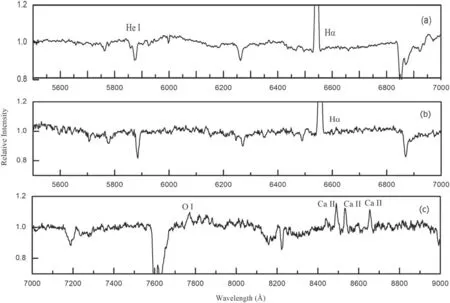
Figure 1.Representative spectra for two of our sample CBe stars,namely HD 280460 shown in panel a and TYC 2679-432-1 presented in panels(b)and(c).While the spectrum of HD 280460 is obtained using the OMR instrument at the VBT facility, the spectrum of TYC 2679-432-1 is taken with the HFOSC instrument mounted on the HCT facility.
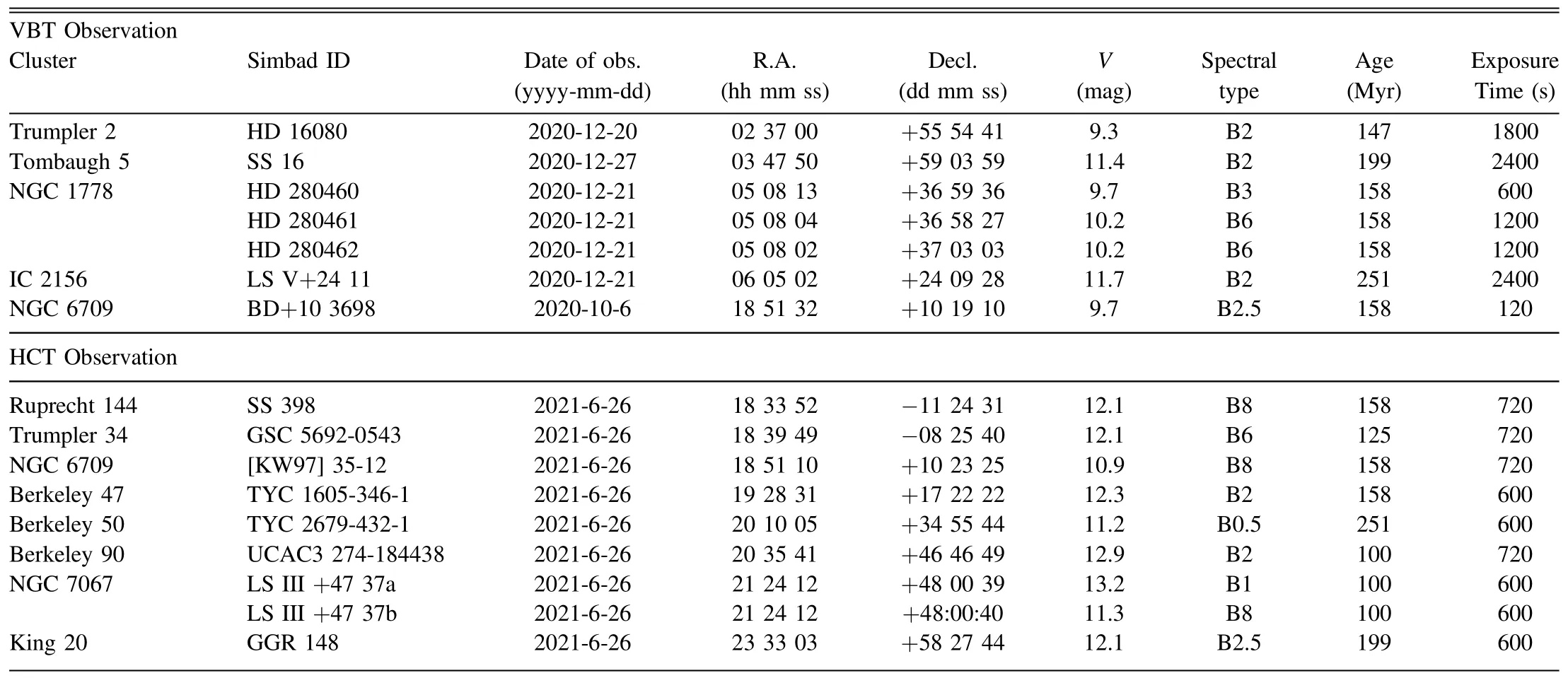
Table 1 Observation log of 16 CBe Stars Identified in Open Clusters Older than 100 Myr
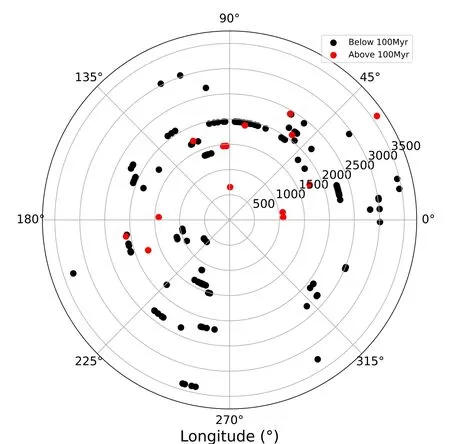
Figure 2.Spatial distribution of our sample of 16 CBe stars older than 100 Myr and 150 CBe stars younger than 100 Myr(taken from Mathew et al.2008)with respect to estimated distances from the Gaia DR3 data.It is noticed that all of our sample of 16 CBe stars in older clusters is located in the longitude range between 0° and 225°.
During our previous study(Jagadeesh et al.2021),we found two stars ([KW97] 35–12 and HD 16080) exhibiting Hα in absorption.Both were confirmed to be B-type stars by Jagadeesh et al.(2021).Interestingly, Hα in emission has been reported for both these stars in the past.This raised the possibility that they might be CBe stars which are passing through a disk-less state.Showing variability in spectral line profiles is a common property of CBe stars.In extreme cases,Hα emission line completely disappears, indicating a disk-less phase in CBe stars.The spectrum then appears to be similar to that of a normal B-type star exhibiting photospheric absorption lines.Literature review confirms that a good number of CBe stars have shown such a transient nature at least once in their lifetime(a few recent works are Mathew&Subramaniam 2011;Mathew et al.2013; Klement et al.2019; Cochetti et al.2021;Ghoreyshi et al.2021;Marr et al.2021).Hence,we studied the two stars [KW97] 35-12 and HD 16080 to analyze the variability in their spectral features.
3.2.1.[KW97] 35–12
A less studied star, [KW97] 35–12, showed Hα in absorption when observed by us on 2015 July 8 (Jagadeesh et al.2021) using slitless spectroscopy.However, when observed with the HCT, we found that Hα emission exists

Table 2 Spectral Features Observed in Our Sample of 16 CBe Stars
Note.The measured and corrected Hα EW values for every star are listed in columns 2 and 3, respectively.We estimated the corrected Hα EW for all 16 stars following the method described in Section 3.4.1 of Banerjee et al.(2021).The (-) sign signifies emission, a whereas positive value means absorption.The terms e, a and eia stand for “emission,”“absorption”and “emission in absorption,”respectively.below the continuum for this star with an EW of-0.5 Å.This is suggestive that it might be a weak Hα emitter in nature,which can be confirmed through further spectroscopic studies.It can be noted that such weak Hα emitters have been identified already in the case of field CBe stars (Banerjee et al.2021).Other spectral features observed for this star are listed in Table 2.
3.2.2.HD 16080
Interestingly, Hα was visible in absorption when we observed HD 16080 on 2016 January 2 (Jagadeesh et al.2021) using slitless spectroscopy.In our present study, we found that Hα exhibits emission in its absorption profile,having an EW of -8.9 Å, when observed with the VBT facility.Apart from Hα, no other spectral feature is visible for HD 16080.
Our results thus confirm that both these objects are CBe stars in nature.However, we could not confirm whether they have passed through some disk-less episodes in 2015(in the case of[KW97]35–12)and 2016(for HD 16080), since we could not measure the Hα EW during our previous study using slitless spectroscopy (Jagadeesh et al.2021).Moreover, with both these stars being less studied, no literature exists reporting Hα in absorption using spectroscopic analysis until date.
3.3.LS III +47 37: A Possible Visual Binary System
LS III +47 37 is a visual pair system located in the cluster NGC 7067 (Monguió et al.2017).Situated at a distance of 3600 pc,NGC 7067 has an age of 100 Myr(Becker 1965).LS III+47 37a,having Gaia ID 2164725643889832960,is one of the components of this system.Monguió et al.(2017)detected it to be a CBe star of spectral type close to B0.5.When observed with HCT, we noticed that this star exhibits Hα in emission, having an EW of -6 Å.The HeI 5876 Å line is also visible in absorption.
LS III +47 37b is the other component of the system.We estimated the spectral type of this star to be B8 using the photometric technique mentioned in Jagadeesh et al.(2021).The V magnitude is obtained from Monguió et al.(2017).Interestingly, Hα showed single peak emission with EW of-4.2 Å (without absorption correction), when we observed it with HCT.Our study thus confirms this object to be a CBe star for the first time.Additionally, the emission line of OI 7772 Å is detected in case of LS III +47 37b.A prominent absorption line of HeI 5876 Å is also visible.
Moreover, since the other component (LS III +47 37a) of this system was also identified as a CBe star,this might become an interesting pair of CBe stars,if it is confirmed to be a binary system.Looking into the newly available data from Gaia DR3,we found that the distance of LS III +47 37a is reported as 3412 pc.For the other star, LS III +47 37b, no distance is available in Gaia DR3.So, we could not confirm the binary nature of this system.Binary systems containing one CBe star and another compact object companion have been detected in several previous studies (e.g., Okazaki & Negueruela 2001;Kennea et al.2021; Bhattacharyya et al.2022).However,literature review reveals a scarcity of studies related to binary systems containing both CBe stars.Hence, we suggest further investigation of the LS III+47 37 system to confirm its binary nature.
3.4.Hα Equivalent Width Distribution
Before examining other spectral lines, we first checked the Hα EW distribution in our sample.Our results show that the Hα EW for all 16 stars ranges within-0.5 to-44.4 Å.Out of 16, 15 (~94%) stars show Hα EW <-40 Å.This result is in agreement with Banerjee et al.(2021) who found that the Hα EW values in CBe stars are mostly lower than-40 Å.The star GSC 5692-0543 exhibits the highest Hα EW among our sample,-44.4 Å,and is the only star possessing Hα EW more than -40 Å.Also, Mathew & Subramaniam (2011) noticed that around 80% of their sample of young cluster CBe stars have Hα EW between -1 and -40 Å.
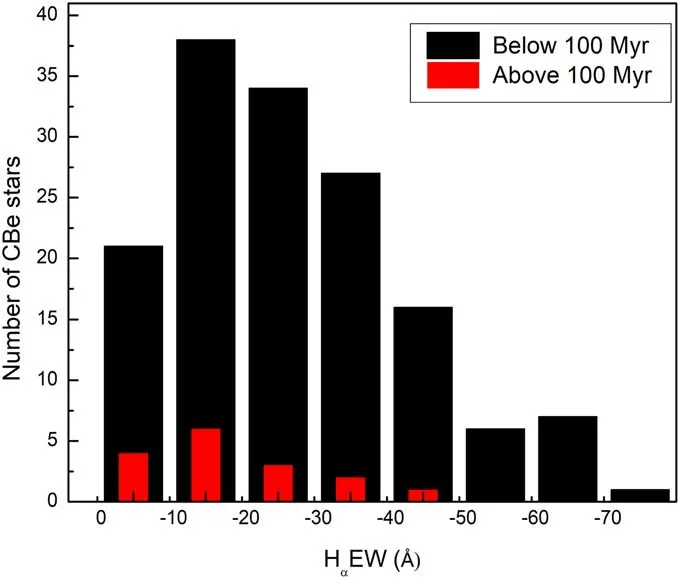
Figure 3.Hα EW distribution for our sample of CBe stars.The black color bars represent CBe stars in clusters younger than 100 Myr obtained from Mathew & Subramaniam (2011) and the red bars signify our sample of CBe stars in clusters older than 100 Myr.
The Hα EW distribution for our sample of CBe stars is depicted in Figure 3.Here, the black color bars represent CBe stars in clusters younger than 100 Myr obtained from Mathew& Subramaniam (2011) and the red color bars represent our sample CBe stars in clusters older than 100 Myr.It is noticed from the figure that 5 out of our sample of 16 stars fall in the bin range of -10 to -20 Å, whereas another 3 are located between the bin range of -20 to -30 Å.A similar peak is noticed in the sample of Mathew&Subramaniam(2011).This result indicates that the Hα EW for CBe stars in young or old clusters might not be affected due to different environments having different metallicity.However, while we observed that most of our sample stars fall in the bin range of-10 to-20 Å,Mathew & Subramaniam (2011) found most of their sample stars to be within the -10 to -30 Å bin range.
Moreover, we performed a comparative analysis of the distribution of Hα EW against the spectral types for CBe stars in clusters with ages below and above 100 Myr.Figure 4 presents this plot where the black dots represent CBe stars with ages below 100 Myr and red dots represent CBe stars with ages above 100 Myr.It is observed from the figure that the Hα EW for early type CBe stars (within B1–B2) situated in young clusters spans almost the whole range from -0.5 to -70 Å.The Hα EW range appears to decrease as we move to late types.Any such trend could not be confirmed in the case of CBe stars in clusters older than 100 Myr.However, it seems that for CBe stars with ages above 100 Myr, their Hα EW range is comparatively lower than those with age below 100 Myr.
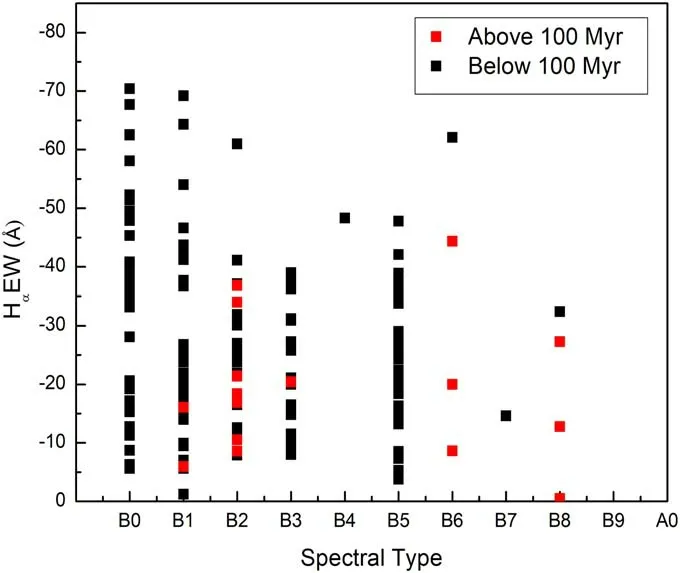
Figure 4.Distribution of Hα EW against the spectral types for CBe stars in clusters with ages below and above 100 Myr.Here, the black dots represent CBe stars younger than 100 Myr and red dots signify CBe stars older than 100 Myr.
3.5.Spectral Features Observed in CBe Stars in Young and Old Clusters
Among our sample of 16 CBe stars, we found that the Hα line is visible as a single-peaked emission profile for 12 stars.Hα emission is detected to exist below the continuum for only one star, [KW97]35–12 (discussed in Section 3.2).The other two stars (BD+10 3698 and HD 16080) show the Hα line in emission in the absorption profile.It is also observed that 6 among the 15 stars exhibit the HeI 6678 Å line in absorption.Moreover,the FeII 4926 Å absorption line is seen in the case of only one star, i.e., SS 16.
We detected emission lines belonging to the hydrogen Paschen series for two stars, i.e., GSC 5692-0543 and TYC 1605-346-1, which featured the series lines from P11–P17 and P11–P20,respectively.One other star,SS 398 displays Paschen lines (P11-P13) in absorption.Furthermore, out of these eight,only three stars (GSC 5692-0543, TYC 1605-346-1 and[KW97]35–12) are seen to exhibit the OI 7772 Å absorption line.On the contrary, the OI 7772 Å line is seen in emission only in one case, LS III +47 37b.Interestingly, CaII triplet emission lines are also found in one among these eight stars,TYC 2679-432-1.This result indicates that CaII emission lines are visible in ~13% of our sample stars, in good agreement with Banerjee et al.(2021).Circumbinary disks have been suggested as one of the probable CaII triplet line forming regions in CBe stars by Banerjee et al.(2021).However, for TYC 2679-432-1, being an unstudied star, we could not confirm whether or not it belongs to a binary system.
Surprisingly,we did not observe any emission line of FeII or even the OI 8446 Å emission line in any of our sample of CBe stars.Both of these are commonly observed emission features in CBe stars, whether in young clusters (Mathew &Subramaniam 2011) or in the field population (Banerjee et al.2021).Moreover, although rare, no emission features of MgII or NaI were identified in the spectra of our sample.From the present study, we observed that CBe stars older than 100 Myr exhibit a lesser number of emission features compared to CBe stars younger than 100 Myr.
3.6.Distribution of B-type and CBe Stars in Selected Open Clusters Younger and Older than 100 Myr
For checking the incidence of CBe stars with respect to B-types in our studied clusters, we performed an individual distribution study of B-type and CBe stars for all 11 clusters older than 100 Myr.The distribution plots of B-type and CBe stars located in all these 11 clusters are shown in Figure 5.Here, the blue bars represent the number of B-type stars in respective clusters obtained from the literature.The orange bars signify the CBe stars identified by Jagadeesh et al.(2021)situated in the respective clusters.
It is visible from Figure 5 that the B-type stars display a peak incidence at B8-B9, in the case of six clusters.A bimodal distribution in spectral types is noticed for B-type stars in the clusters NGC 1778 and Trumpler 2, peaking at B1-B2 and again at B8-B9.However, any such incidence could not be firmly identified for the other three clusters (Berkeley 50,Berkeley 90 and Ruprecht 144).Interestingly,it is apparent that the CBe stars identified by Jagadeesh et al.(2021) are also located around those peaks where B-type stars are situated,except for one case,NGC 1778,where the identified CBe stars are found to be of B6 type.It is interesting to notice that CBe stars also seem to follow such a trend similar to B-types in our other studied clusters.
So for further checking, we also constructed the distribution plots for CBe stars with respect to B-types in young open clusters (depicted in Figure 6).The selected 10 young clusters containing CBe stars are taken from Mathew et al.(2008).We have not included any rich open cluster in the analysis since the distribution is found to preferentially peak at early B-type (see the discussion in Mathew et al.2008).In Figure 6 the blue and orange bars represent B-type and CBe stars in their parent clusters,respectively.It is seen that B-type stars display a peak incidence near late types, i.e., B8-A0, in the case of four clusters.A bimodal distribution in spectral types is noticed for B-type stars for the other six clusters.While in clusters Berkeley 86, NGC 1624, NGC 7235, NGC 637 and NGC 7128, the peaking is observed near B2 and the B8–A0 region,whereas the remaining cluster Bochum 2 exhibits bimodal peaks near B5–B6 and B8–B9,respectively.Similar to the case of clusters with ages above 100 Myr(Figure 5),it is found here also that the CBe stars identified by Mathew et al.(2008) are mostly located around these peaks where B-type stars are situated, except for two cases, NGC 146 and NGC 637 where the identified CBe stars are found to be of B6 type.Our result thus suggests that the existence of CBe stars can depend on the spectral type distribution of B-type stars.
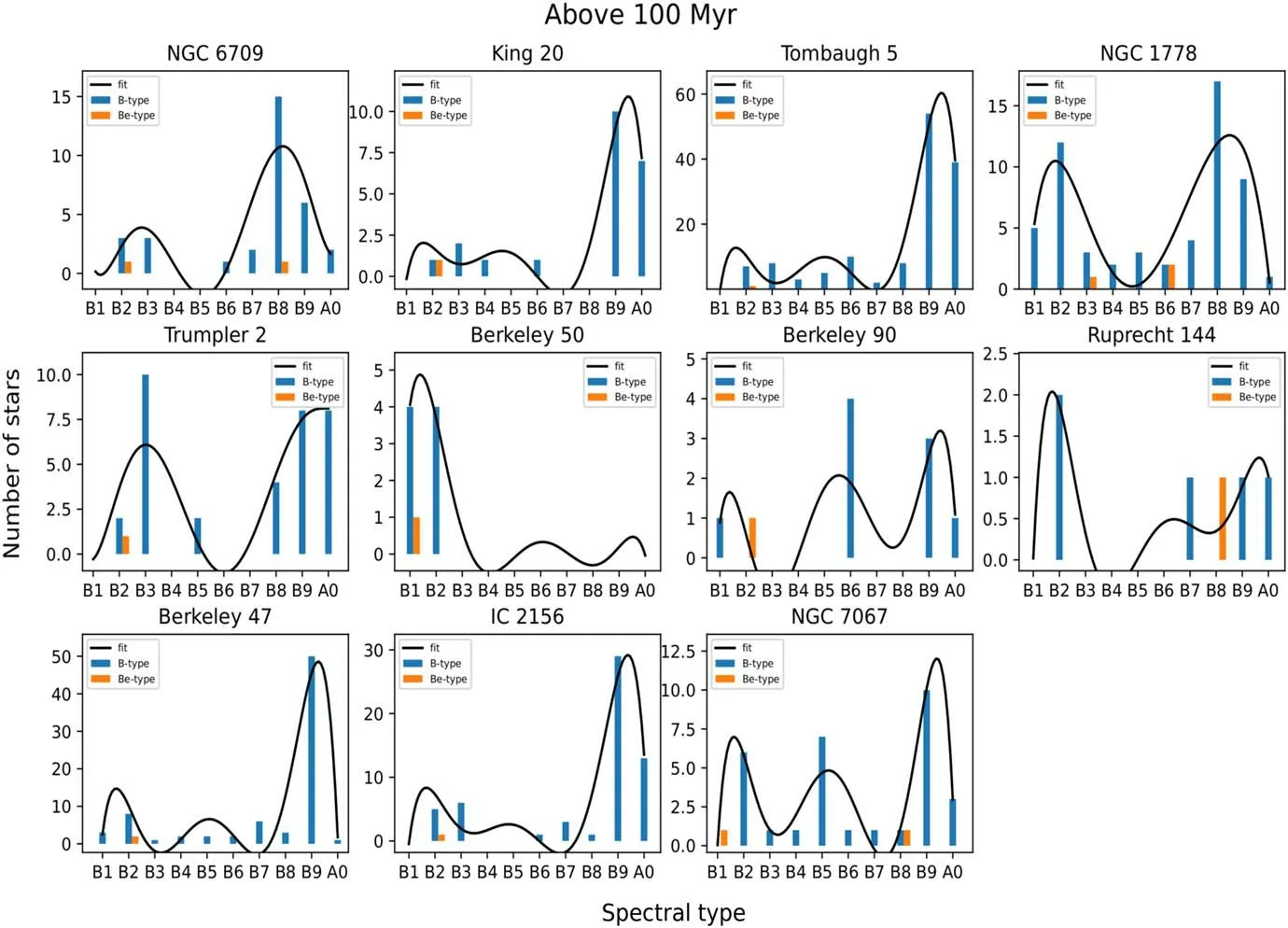
Figure 5.Plots for all 11 old open clusters showing the distribution of B-type and CBe stars in respective clusters.Here,the blue bars represent the number of B-type stars in the respective clusters as referenced from the literature.
4.Conclusions
As a follow-up study to that of Jagadeesh et al.(2021), we performed the optical spectroscopy of a sample of 16 CBe stars in 11 old open clusters in the present paper.Ours is the first spectroscopic study of CBe stars in clusters older than 100 Myr.The prominent results obtained from our study are summarized below:
1.Our study confirms that all 16 stars in our sample are CBe stars.One among these 16 stars,namely LS III+47 37b,is a new detection having spectral type of B8.It belongs to the possible visual binary system LS III+47 37,where the other companion is also a CBe star as confirmed by the present study.
2.We found that these 16 stars exhibit a lesser number of emission features compared to CBe stars which are younger than 100 Myr (Mathew & Subramaniam 2011).None of them show any FeII emission lines.Interestingly,the OI 8446 Å emission feature is noticed in only one star(LS III +47 37b) and Paschen lines are found to be present in emission in only two cases, i.e., SS 398 and GSC 5692-0543.However,these are commonly observed features in the optical spectra of CBe stars, whether in fields(Banerjee et al.2021)or in young clusters(Mathew&Subramaniam 2011).Hence,our study found that CBe stars belonging to clusters older than 100 Myr exhibit a lesser number of emission features compared to CBe stars which are younger than 100 Myr,which is what is usually expected.
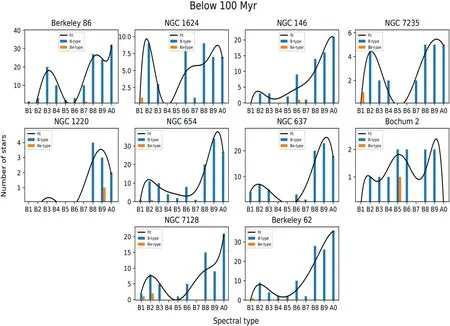
Figure 6.Distribution plots for CBe stars with respect to B-types in 10 selected clusters(taken from Mathew et al.2008)younger than 100 Myr.Here,the blue and orange bars represent B-type and CBe stars in their parent clusters, respectively.
3.Our analysis also suggests that one out of these 16 stars,[KW97] 35-12, might be a weak Hα emitter in nature,showing Hα EW of -0.5 Å.
4.Moreover, we detected that the Hα EW for 15 (~94%)out of 16 of our sample stars is <-40 Å, in agreement with Banerjee et al.(2021).Interestingly,our comparative analysis with CBe stars from young clusters (younger than 100 Myr)points out that the Hα EW for CBe stars in young or old clusters might not be affected by different environments having different metallicity.
5.Furthermore, we performed an individual distribution study of B-type and CBe stars for all clusters.Our analysis points out that the existence of CBe stars can depend on the spectral type distribution of B-type stars present in these clusters.
Apart from Jagadeesh et al.(2021),quite a number of studies by several authors have identified different types of emissionline stars in recent years (e.g., Anusha et al.2021;Bhattacharyya et al.2021; Li 2021; Shridharan et al.2021;Wang et al.2022).Ours is thus a timely study regarding CBe star research.This study will help in motivating the entire Be star community about the need to further identify and examine CBe stars in other older clusters.Detection and study of more CBe stars in fields and in both younger and older clusters may provide new insights about the “Be phenomenon”in diverse environments.Moreover, effects of metallicity in CBe stars have already been noticed in several previous studies (e.g.,Maeder et al.1999; Keller 2004; Martayan et al.2006;Martayan et al.2007, 2007).Hence, further investigations of CBe stars in diverse metallicity environments (such as clusters and fields) might also provide clues about the mechanisms of disk formation and dissipation.
Acknowledgments
We would like to thank the staff of VBO who took the observations using the Vainu Bappu Telescope (VBT) at Kavalur, India.We also thank our colleague Dr.Arun Roy for providing help during the observations.This research has made use of the WEBDA database, maintained by the Institute for Astronomy at the University of Vienna.Moreover, we have used the SIMBAD database, operated at CDS, Strasbourg,France.We thank the administrators of the SIMBAD database for providing necessary help.Lastly, we would like to acknowledge the VizieR online catalog, which has been available since 1996 and was described in a paper published in A&AS, 2000, 143, 23.
ORCID iDs
Madhu Kashyap Jagadeesh https://orcid.org/0000-0003-4075-5646
Gourav Banerjee https://orcid.org/0000-0001-8873-1171 R.Anusha https://orcid.org/0000-0002-9015-6417
 Research in Astronomy and Astrophysics2023年3期
Research in Astronomy and Astrophysics2023年3期
- Research in Astronomy and Astrophysics的其它文章
- Discrepancy in Grain Size Estimation of H2O Ice in the Outer Solar System
- Galactic Dark Matter Halos Containing H I Regions: A Possible Overestimation of the Column Densities
- Limiting Magnitudes of the Wide Field Survey Telescope (WFST)
- Quality Control of YFOSC Data I.The On-site Quick Analysis System
- Principal Component Analysis of Ground Level Enhancement of Cosmic Ray Events
- A Morphological Study of Two Young Multipolar Planetary Nebulae
